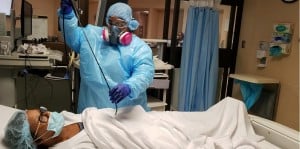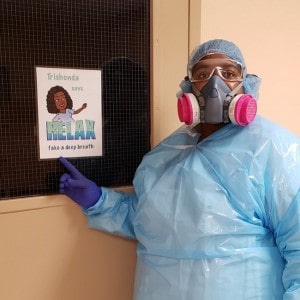As a respiratory therapist, Trishonda Scurlock new her specialty would be crucial in the treatment of COVID-19.
So, when Regional One Health started receiving patients earlier this year, Trishonda put aside any personal fears and volunteered to take the first cases.
She hasn’t slowed down since, and she wouldn’t dream of doing so in the future. She said her job is her passion, and taking care of patients is what she loves to do.
COVID-19 changed how respiratory therapist Trishonda Scurlock, CRT does her job. It changed the equipment she wears. It changed how she performs breathing treatments. It changed the way she interacts with patients and colleagues.
It did not – not for one second – change her desire to take care of people.
“We need to take care of our patients. Someone needs to be there for them,” she said. “When this pandemic hit, it changed a lot of our processes. But it didn’t change my determination or my love for what I do. At the end of the day, I just want to take care of my patients.”
Trishonda decided to study respiratory therapy after a cousin died of an asthma attack at age 10, and she’s been inspired by his memory ever since. She started at Regional One Health shortly after having her first child, working in a rehabilitation unit for patients on ventilators.
When her team became part of the hospital’s respiratory unit, she shifted to working with trauma and intensive care patients. It was a perfect fit: “I thrived,” she said. “I loved it. It was fast-paced, and we saw all sorts of different patients.”

Taking care of patients is Trishonda’s passion. “I absolutely love what I do,” she says. “I love my team, and I love being at the bedside with the patient. I wouldn’t want to be doing anything else!”
She went on to specialize in bronchoscopy, assisting operating room physicians in the diagnosis and staging of cancer. She also continued working in intensive care with the pulmonology and trauma teams, helping patients with asthma, COPD, pneumonia, broken ribs and other conditions that cause breathing difficulty.
Through her education and experience, she saw how respiratory therapy helps patients heal from a variety of illnesses and injuries.
So, when she started hearing about COVID-19 early this year, she knew immediately it would impact her work. Cough, difficulty breathing, and pneumonia are some of the most common and dangerous symptoms of the disease, so respiratory therapy is critical to a patient’s care.
Trishonda never hesitated to step into the unknown, despite the fear surrounding the virus. “I was scared – but not scared for me,” she acknowledged. “I was scared I would give it to my family. I didn’t want to bring it home to my elderly mom or my daughter.”
But she knew she could set aside her fear and make a difference. She volunteered to take the first patients in Regional One Health’s COVID-19 Unit, and she has been there ever since.
It hasn’t been easy. “For a while, we couldn’t see past the horizon, and that was stressful. But we have a great team. If I broke down one day, the nurse would be there for me. Then she’d break down the next day, and I’d be there for her. We’d encourage each other.”
Trishonda works grueling 12-hour shifts in full personal protective equipment, staying vigilant about following the instructions provided by the COVID-19 team and not taking any shortcuts.

Trishonda tries to reassure her patients and lift their spirits. “I’ve prayed with them, I’ve held their hand, I’ve cried with them. I’ve held the iPad so they can see their family,” she said.
At first, her N-95 mask made her nose bleed badly. At the advice of a pulmonologist, she began instead wearing her respirator full-time.
She’s also had to adapt to rapidly changing patient care guidelines.
Breathing treatments were initially ruled out because they would cause infectious particles to be suspended in the air; now, she can give treatments using a filter in a negative pressure room. For a while, high-flow nasal cannulas were out; now they’re allowed if the patient wears a mask.
For Trishonda, it’s a chance to put her natural curiosity to work and embrace the chance to learn and find solutions to problems.
“If I hear something I don’t know about, I go home and read about it and research it, because I want to learn,” she said. “I don’t want to be left behind.”
It’s all been challenging, but the hardest part for Trishonda is seeing patients struggle with illness and fear while isolated from family and friends. “If I see a patient crying, I want to comfort them,” she said. “I can’t give them a hug, but I’ve prayed with them, I’ve held their hand, I’ve cried with them. I’ve held the iPad so they can see their family.”
For someone whose career was inspired by family, it all comes back to treating others how she would want her own loved ones to be treated – and that alone is enough to keep her going: “My husband asks me, ‘Are you tired?’ and I say, ‘I’m not tired yet, because I know these patients need us.’ I don’t want to get tired!”
Fortunately, the pandemic not only taught her a lot about patient care, it has taught her something important about herself.
“I didn’t know I was this strong,” she said. “But I know I can keep being there for our patients, because I absolutely love what I do. It’s my passion. I love my team, and I love being at the bedside with the patient. I wouldn’t want to be doing anything else!”

